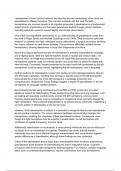Lateralisation of brain function refers to the idea that the two hemispheres of the brain are
specialised for different functions. This concept contrasts with the view that both
hemispheres are involved equally in all cognitive processes. Lateralisation is a fundamental
aspect of brain organisation and has been extensively studied through various methods,
including split-brain research, neuroimaging, and clinical observations.
One of the most significant contributions to our understanding of lateralisation comes from
the work of Roger Sperry and Michael Gazzaniga in the 1960s. They conducted split-brain
research on patients who had undergone corpus callosotomy, a surgical procedure severing
the corpus callosum to treat severe epilepsy. This procedure effectively isolated the two
hemispheres, allowing researchers to study their independent functions.
Sperry and Gazzaniga found that the left hemisphere is primarily responsible for language
and analytical tasks, while the right hemisphere excels in spatial and creative tasks. For
instance, when an image was presented to the left visual field (processed by the right
hemisphere), patients could not verbally identify it but could draw or select the object with
their left hand. Conversely, images presented to the right visual field (processed by the left
hemisphere) could be easily named, highlighting the left hemisphere’s role in language.
Further evidence for lateralisation comes from studies on brain-damaged patients. Broca’s
and Wernicke’s aphasias, resulting from damage to specific areas in the left hemisphere,
demonstrate the critical role of the left hemisphere in language production and
comprehension, respectively. These findings suggest a degree of specialisation in the left
hemisphere for language-related functions.
Neuroimaging studies using techniques such as fMRI and PET scans have provided
additional support for lateralisation. These studies show that tasks involving language, such
as reading and speaking, predominantly activate the left hemisphere, whereas tasks
involving spatial awareness, such as navigating or recognizing faces, primarily engage the
right hemisphere. This functional specialisation is consistent across individuals, suggesting a
common pattern of lateralisation in the human brain.
However, while lateralisation is evident, it is essential to recognize that the two hemispheres
do not operate in isolation. The corpus callosum facilitates communication between the
hemispheres, enabling the integration of their specialised functions. For example, even
though the right hemisphere may be superior in spatial tasks, the left hemisphere still
contributes to spatial processing, and vice versa.
Additionally, lateralisation is not absolute; it varies among individuals and can be influenced
by factors such as handedness and gender. Research has shown that left-handed
individuals may have more bilateral language representation, and some studies suggest
gender differences in lateralisation, although these findings are less consistent.
Critics of the lateralisation theory argue that it oversimplifies brain functions, emphasising
specialisation at the expense of understanding the brain’s integrative nature. Cognitive
processes often involve both hemispheres working together. For instance, complex language
tasks, such as understanding metaphors, require contributions from both hemispheres.




